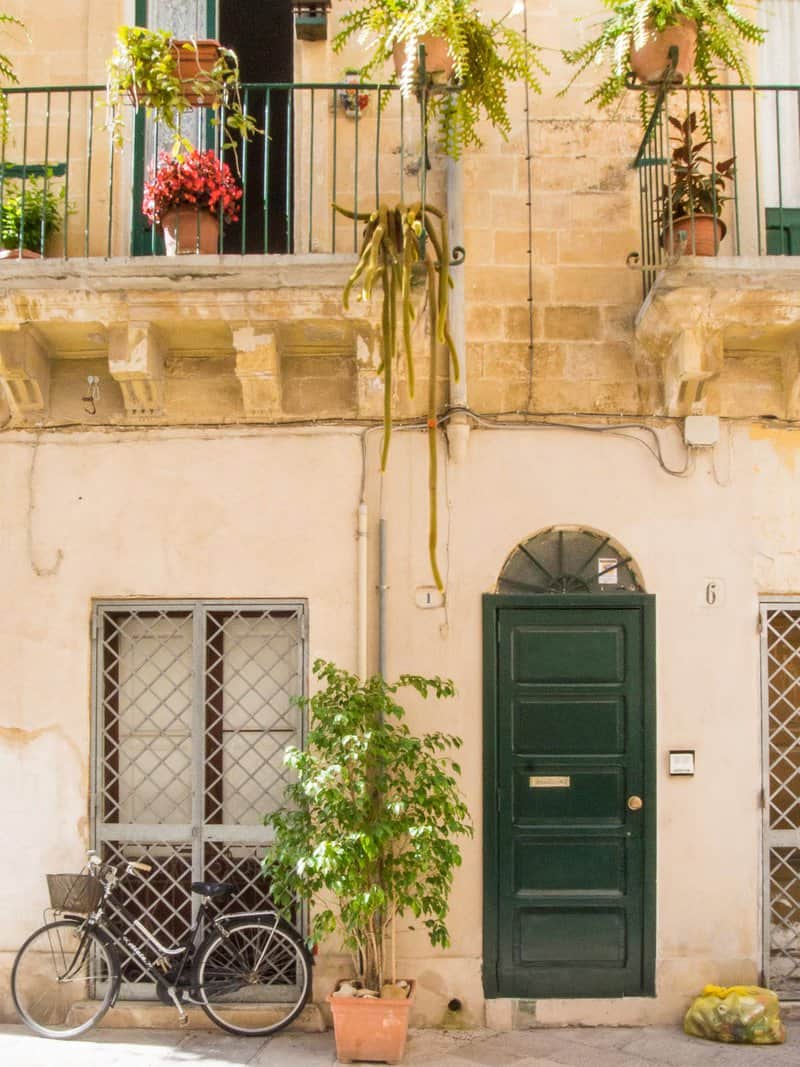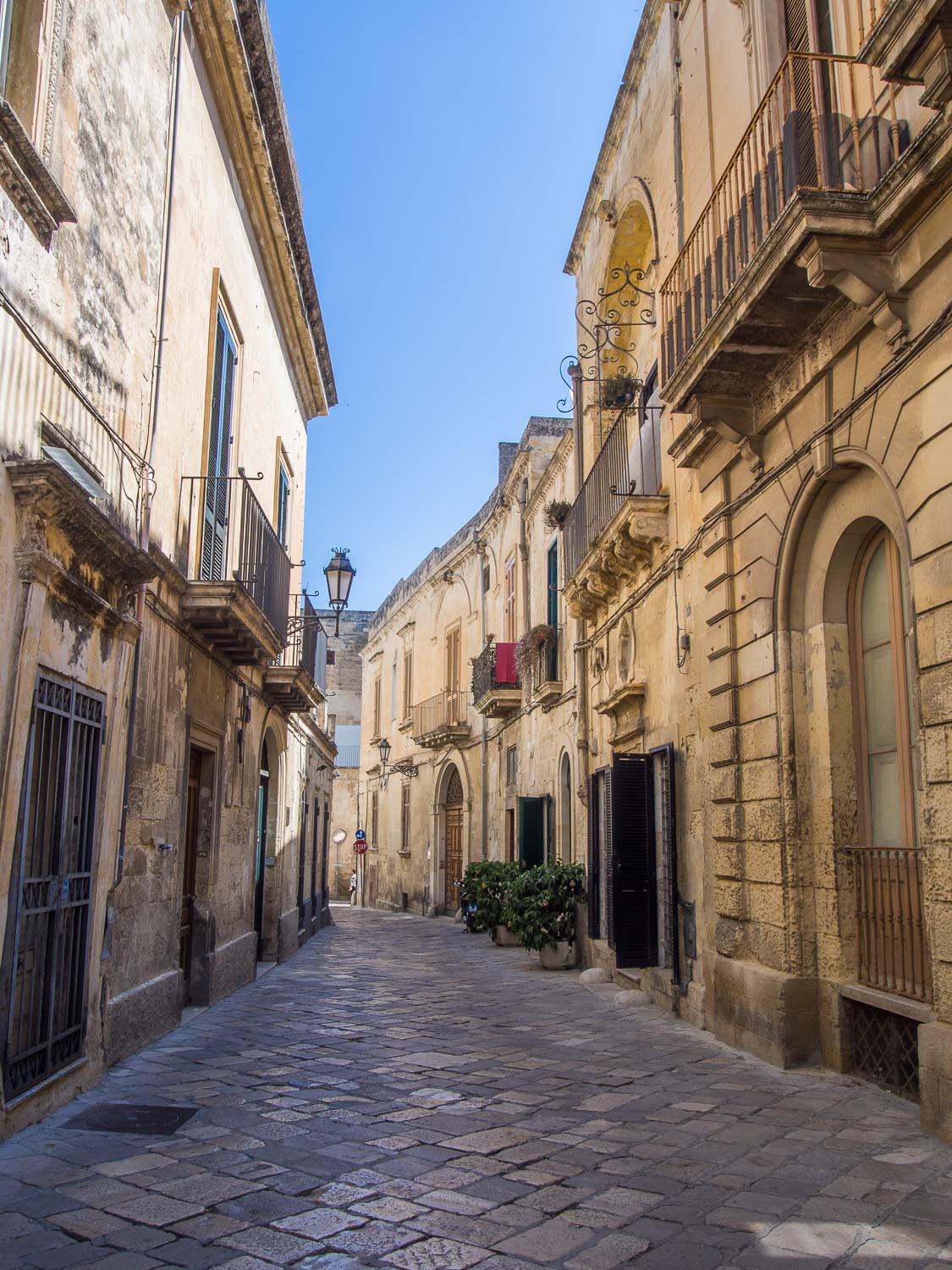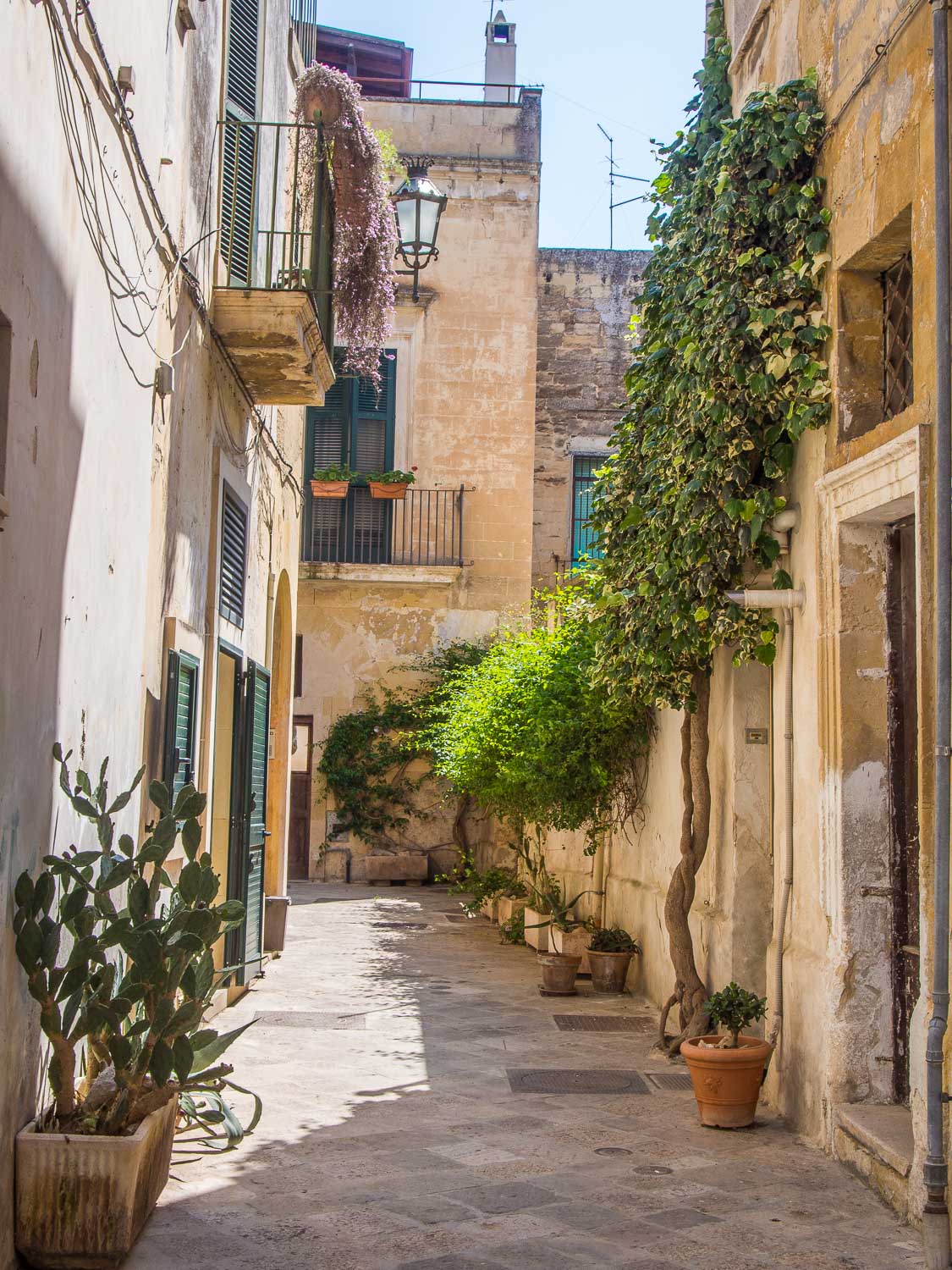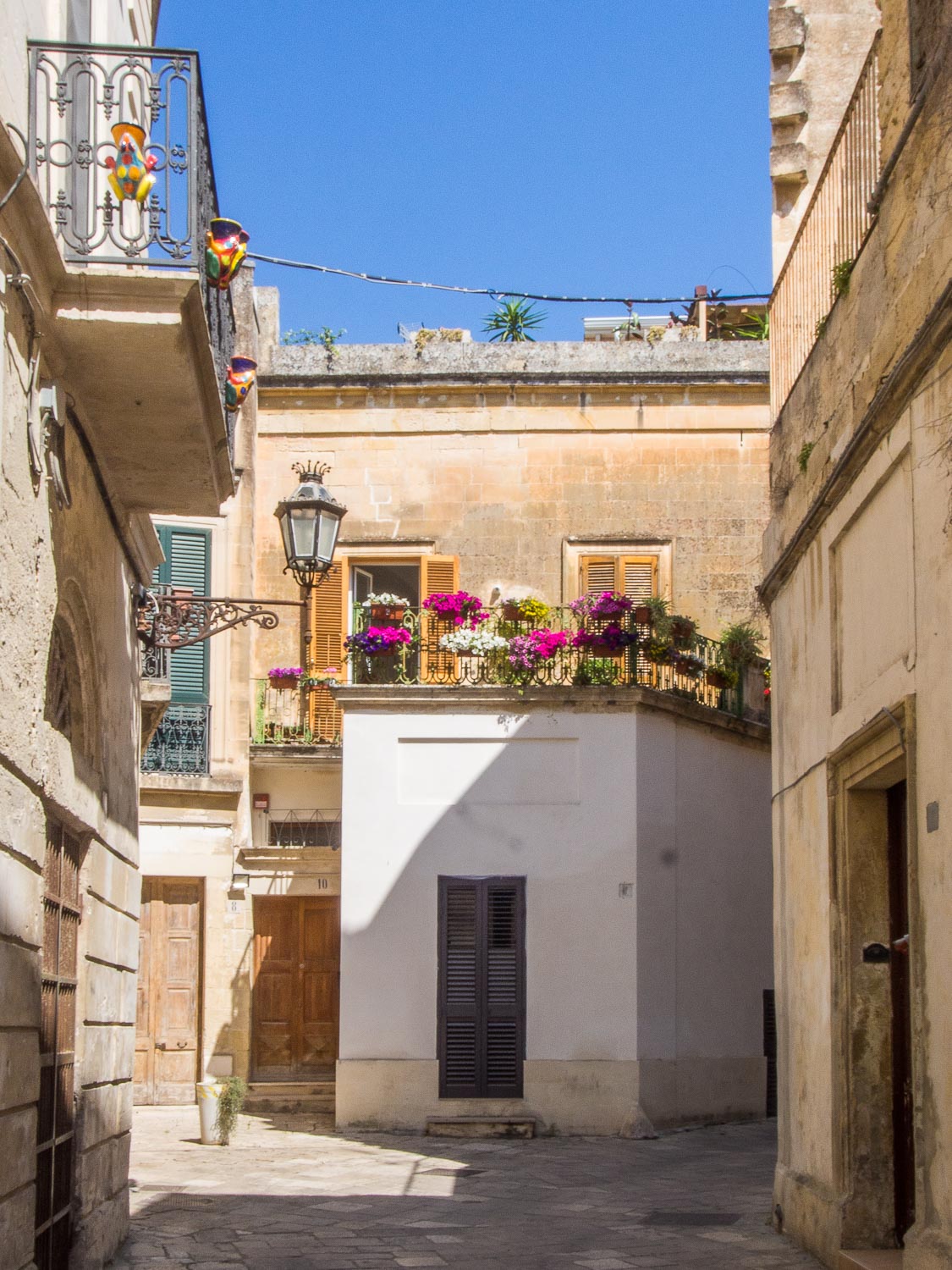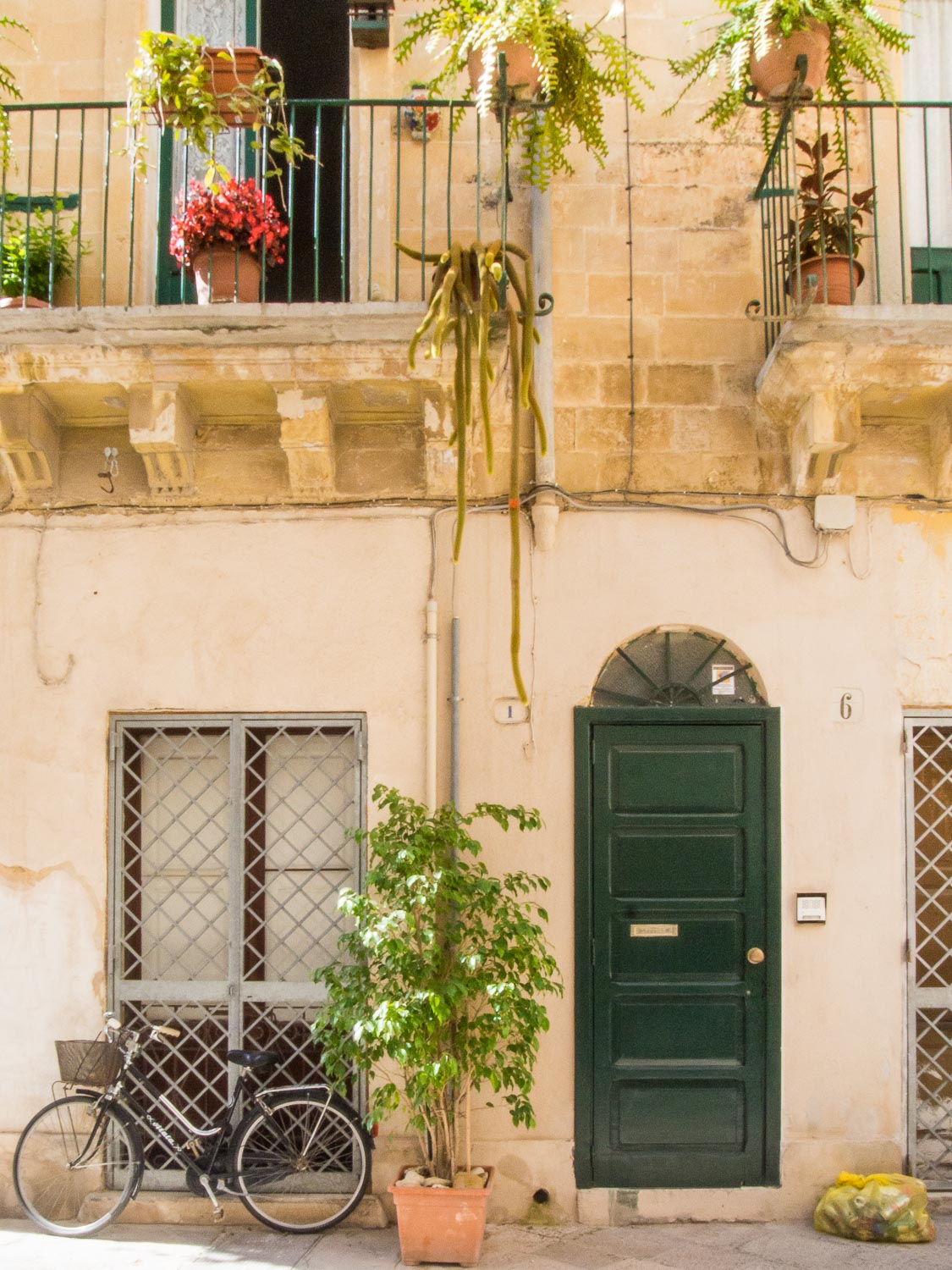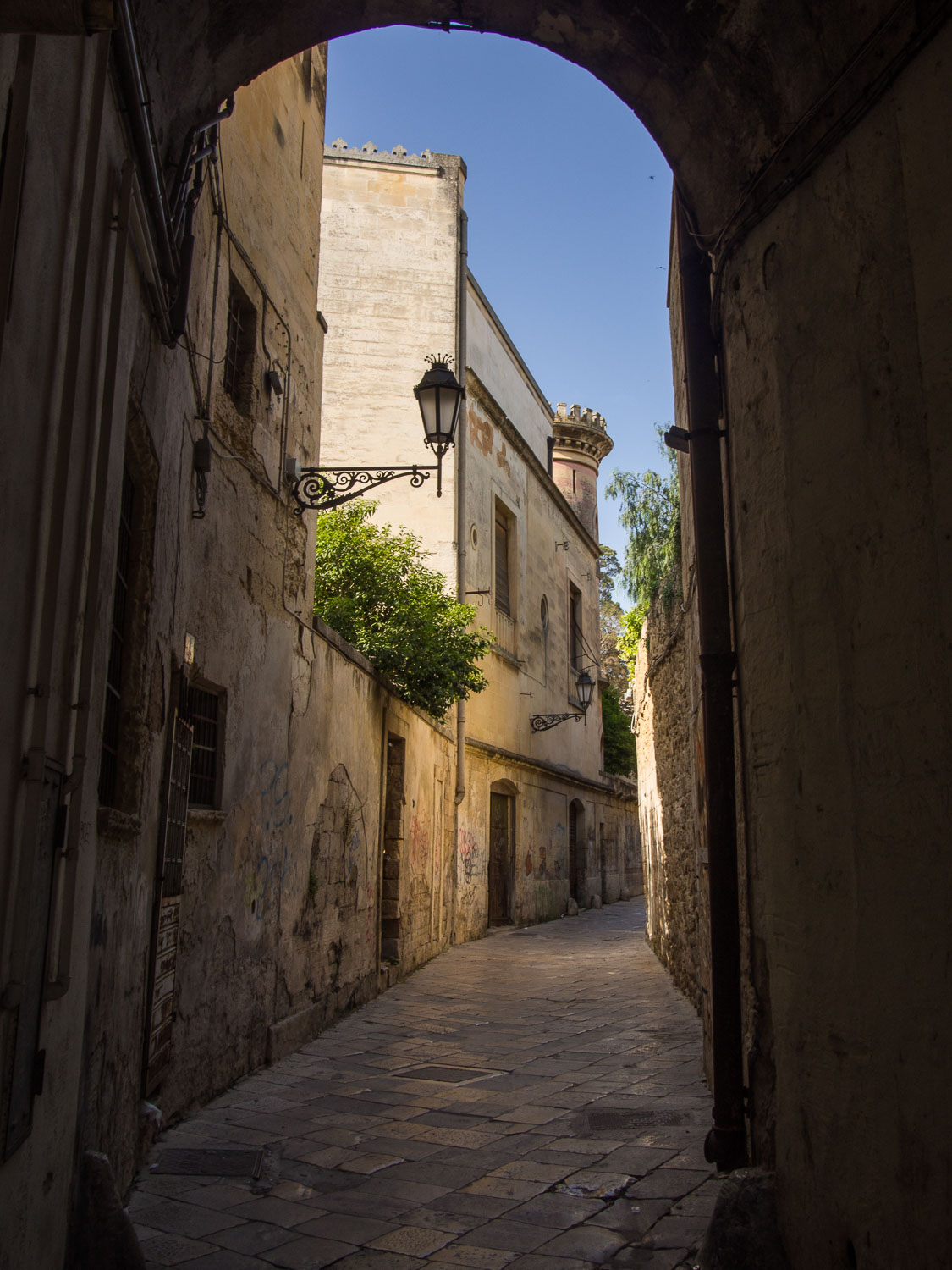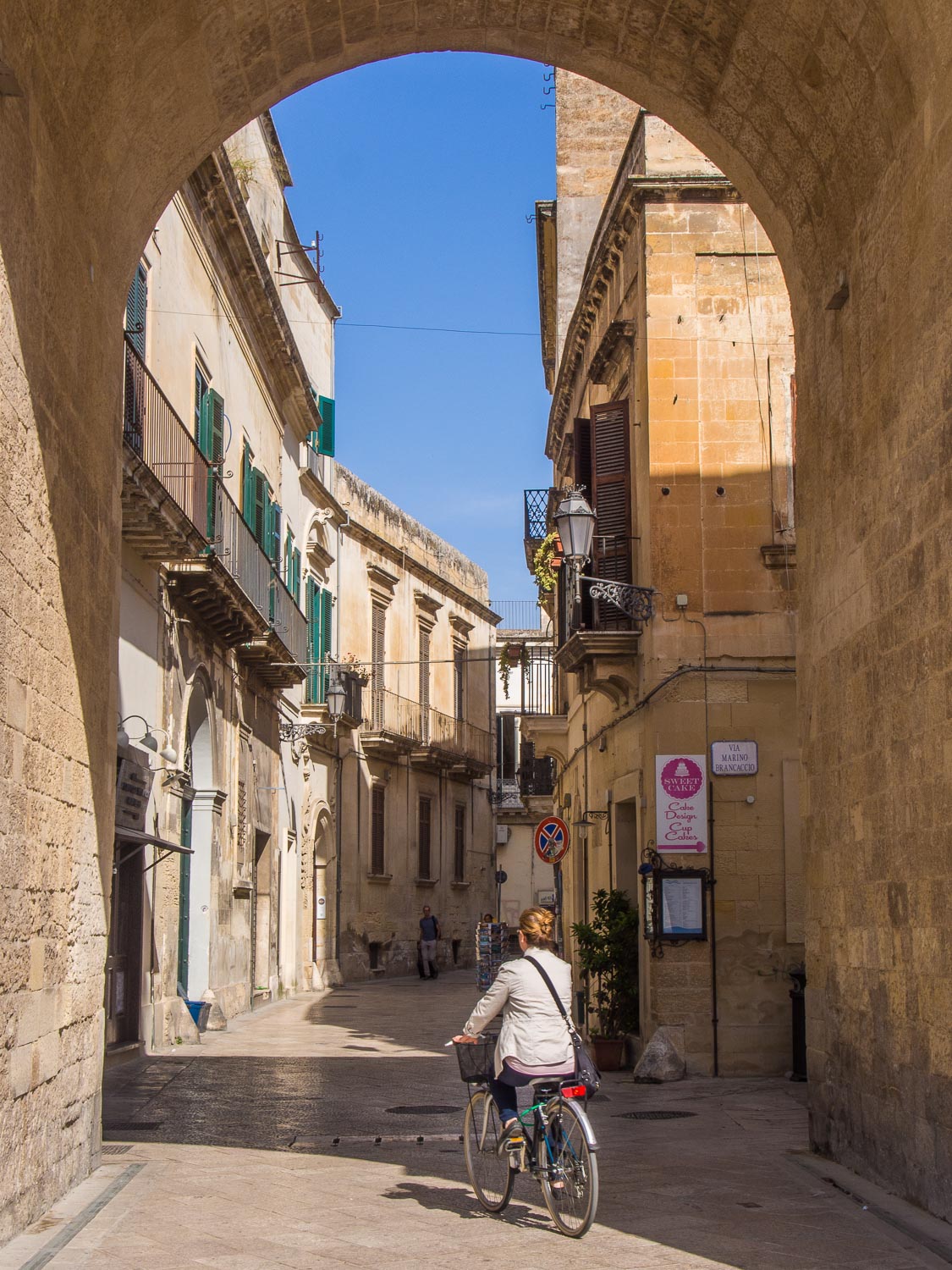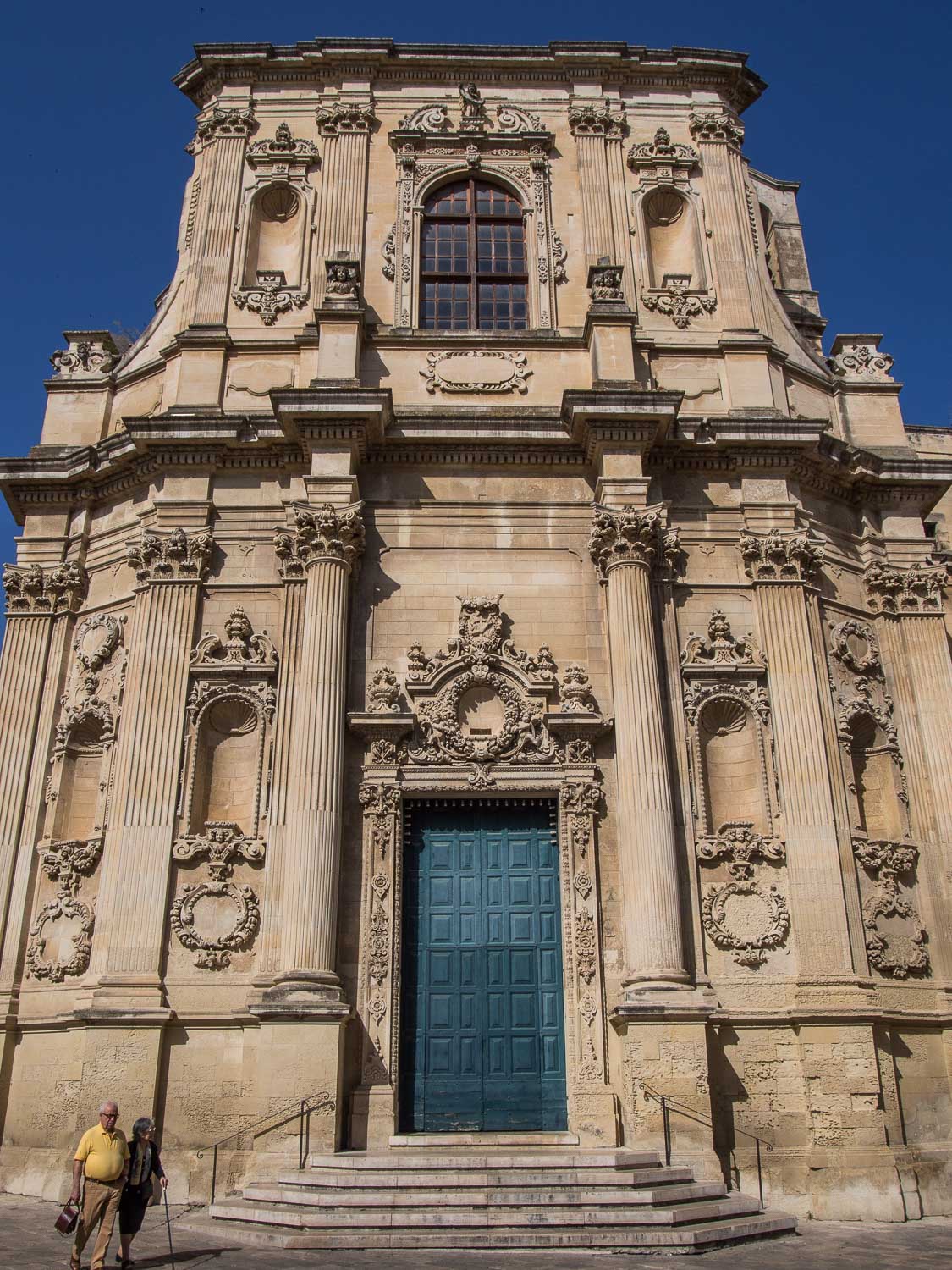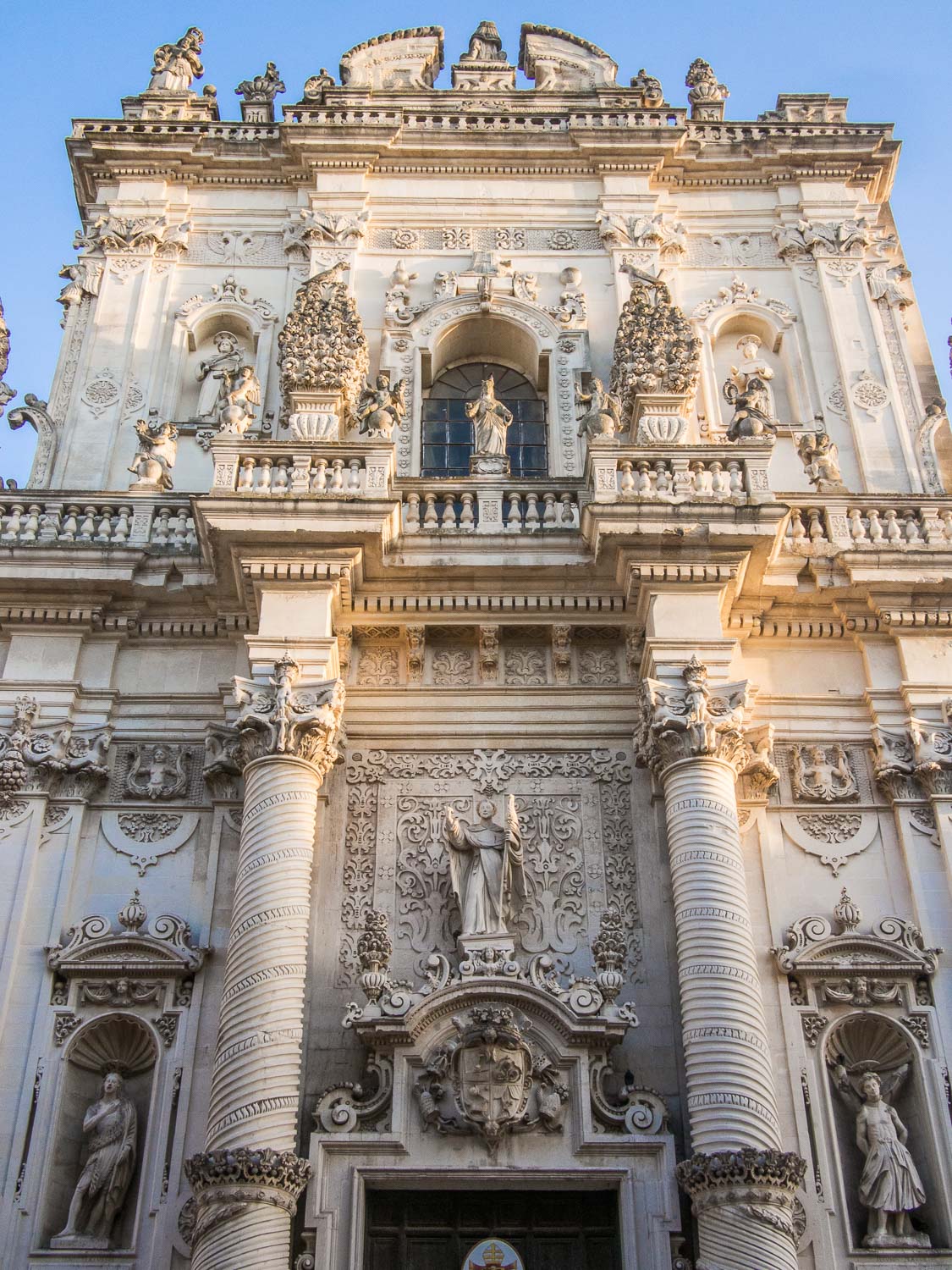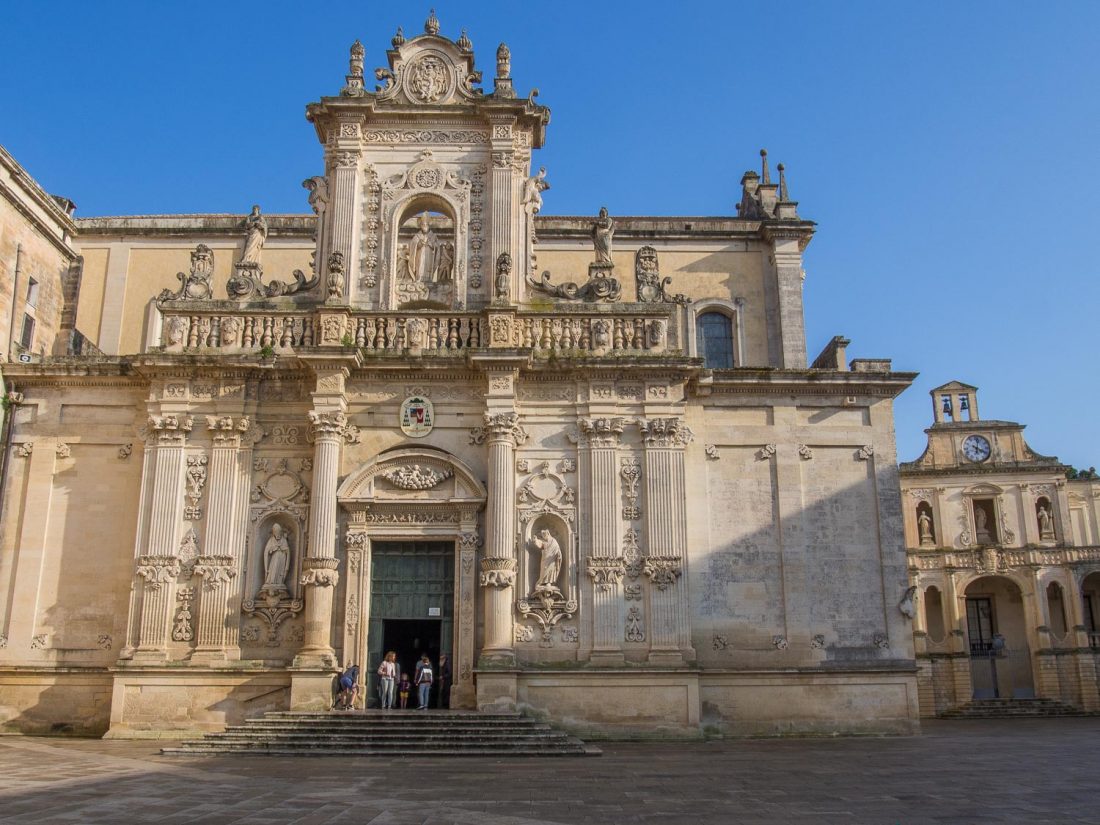
I was planning on writing a post about the best things to do in Lecce, but it’s not really a “doing” kind of place. Sure, there are a few museums and dozens of churches to visit, but none of them are must-sees.
Instead, Lecce is for experiencing—for wandering the narrow streets of golden sandstone, for finding hidden piazzas, for lazy lunches in wine bars with a glass of local rose and a view of an extravagantly carved baroque church.
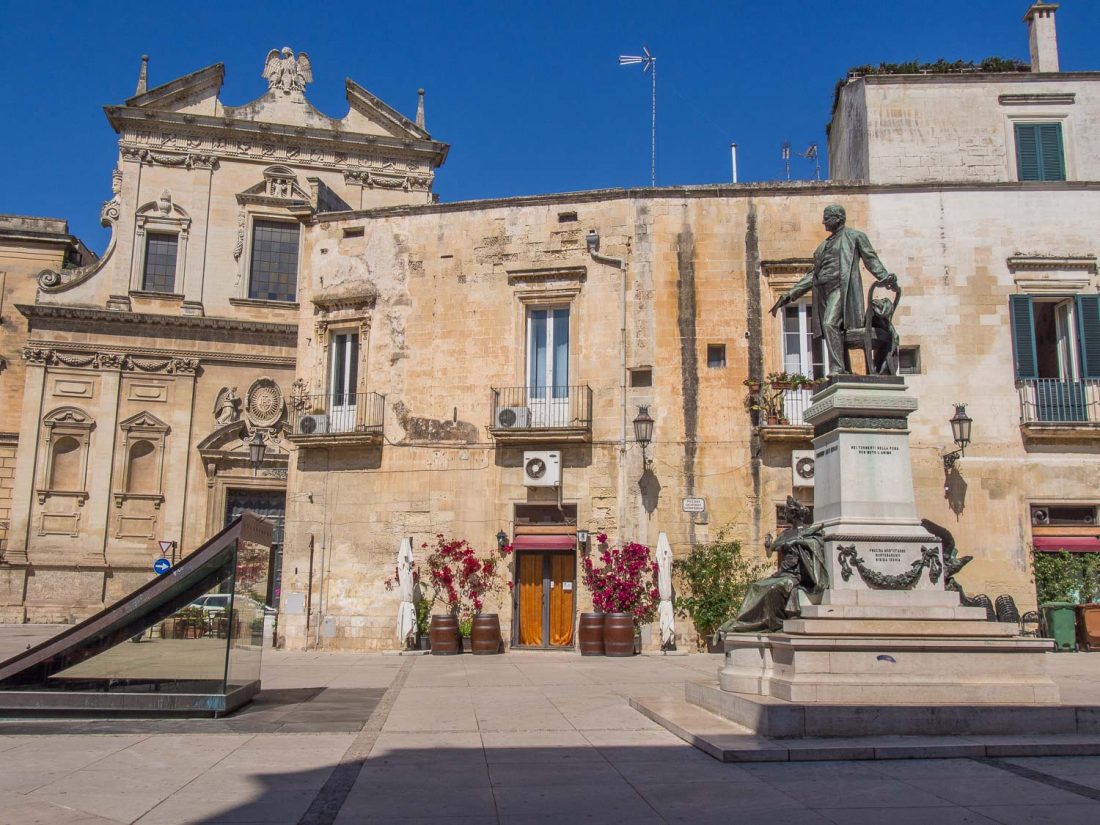
One of our favourite piazzas in Lecce
On our third visit to Lecce, we spent a month in this small university city (population: 96,000) located in the Salento region of Puglia in the heel of Italy’s boot. Most visitors only come for a day or two, but we never got bored on our extended stay. It’s just too gorgeous a place, and despite the historic centre’s small size, we always found a new hidden corner on our daily walks. Traffic is limited in the centre so it’s a pleasure to wander.
And then there’s the food. Morning pastries with iced almond milk coffee, a puff pastry rustico for lunch, evening aperitivo snacks, and multi-course dinners of generous vegetable antipasti and hearty plates of pasta, topped off with a gelato and a stroll along the beautifully lit streets. Puglia is our favourite Italian region for eating and it’s wonderfully vegetarian-friendly (although fish and meat lovers will find plenty on offer too).
Lecce has grown in popularity since our last visit five years ago and the tour groups have arrived, but it’s nothing compared to the crowds of Florence or Rome. All you have to do is head down a side street to find a quiet spot to yourself.
Things to Do in Lecce, Italy
Although I said there are no must-sees in Lecce, here are some places and activities that you could include in your wanderings. I recommend picking up a map from the tourist office on the main square Piazza Sant’Oronzo. You can also see our Lecce map below featuring all our favourite places.
Roman Amphitheatre and Piazza Sant’Oronzo
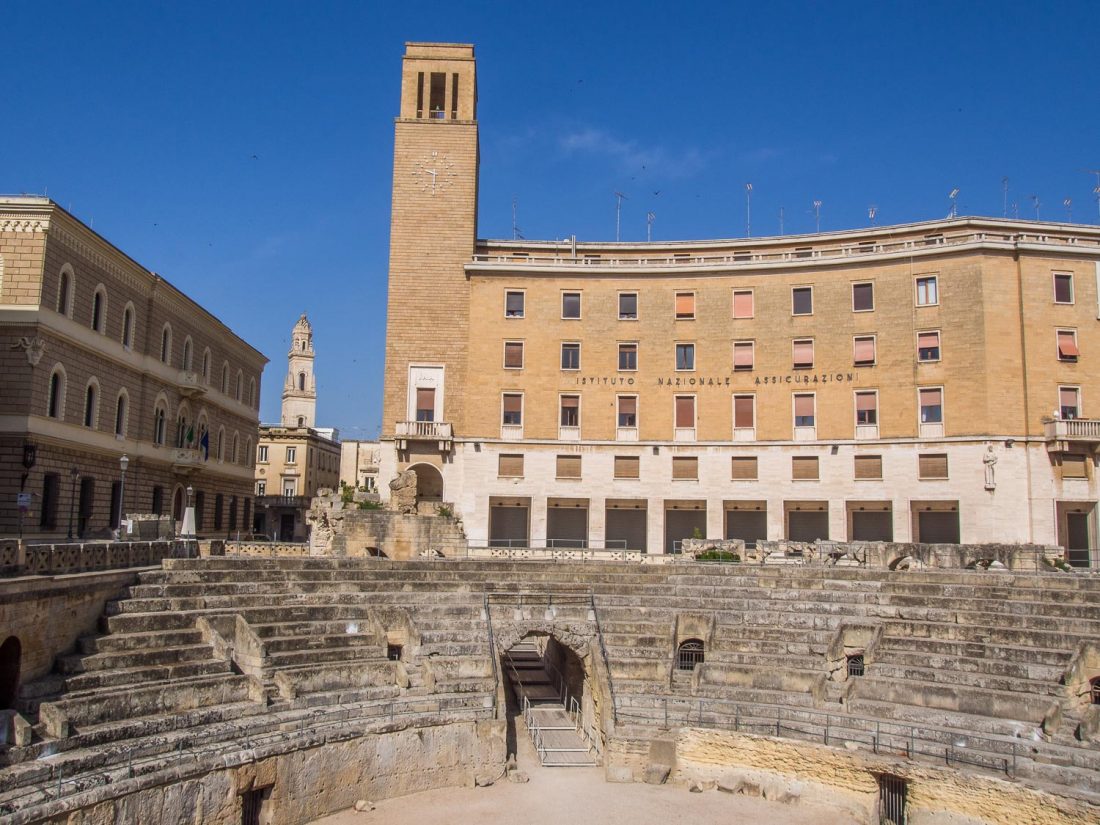
The Roman amphitheatre in Piazza Sant’Oronzo
A good starting point for your Lecce explorations is the city’s main square, Piazza Sant’Oronzo. The highlight is the large Roman amphitheatre which once seated 14,000 spectators on its two tiers, although only the lower tier remains—sometimes concerts still take place here.
In the piazza you can also see the column of Sant’Oronzo (currently covered up for restoration work) and an unusual 20-meter high bronze clock, the Orologio Delle Meraviglie, created in 1955 on the wall of the Banco di Napoli.
If you are in need of refreshment, Caffe Alvino is a good place for a coffee and pastry or aperitivo.
Lecce Cathedral
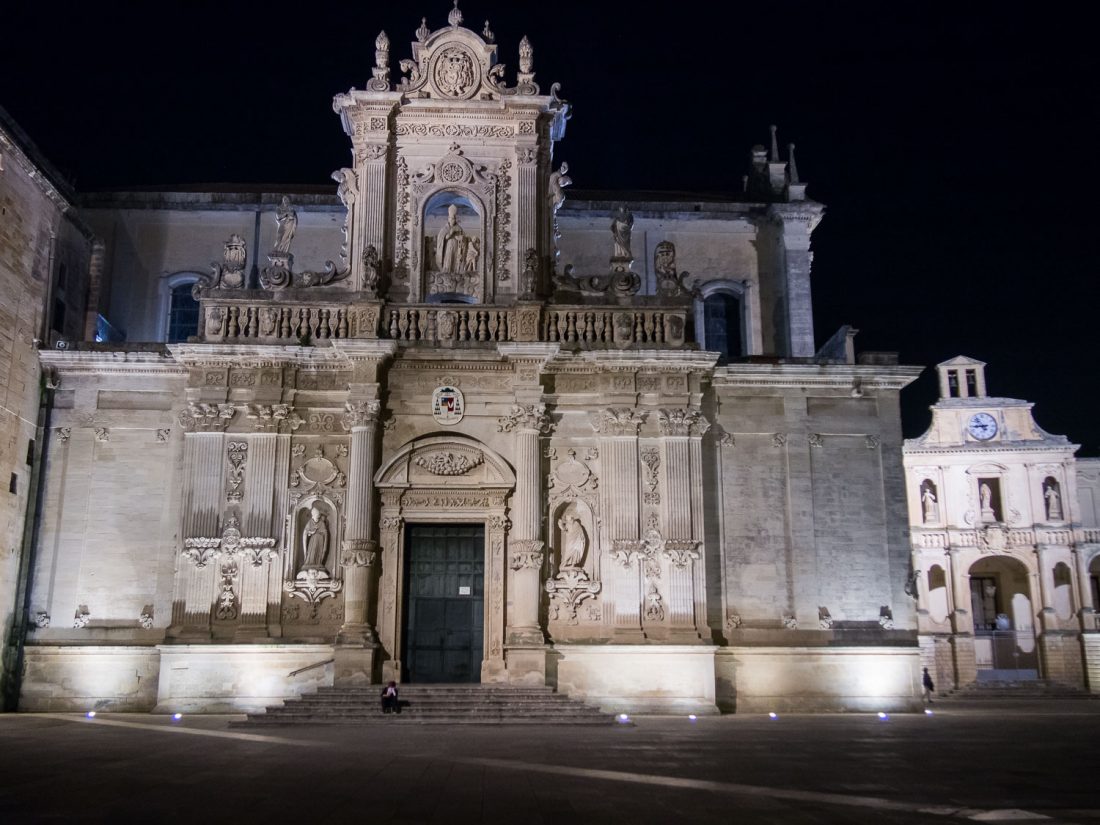
Lecce Cathedral at night
Lecce’s Cathedral is on one of the most beautiful squares in Lecce, the Piazza del Duomo. Unlike Piazza Sant’Oronzo which is bustling with cafes and shops, the Piazza del Duomo has a more intimate feel and is enclosed by ornate buildings including the bishop’s residence and seminary.
The Cathedral was originally built in 1144 and was rebuilt in the 17th century by architect Giuseppe Zimbalo in the decorative baroque style that now characterises the city.
It’s also worth seeing the Duomo lit up at night.
Lecce Cathedral is free and is open 8.30 am –12.30 pm and 4 pm – 6.30 pm.
Basilica di Santa Croce
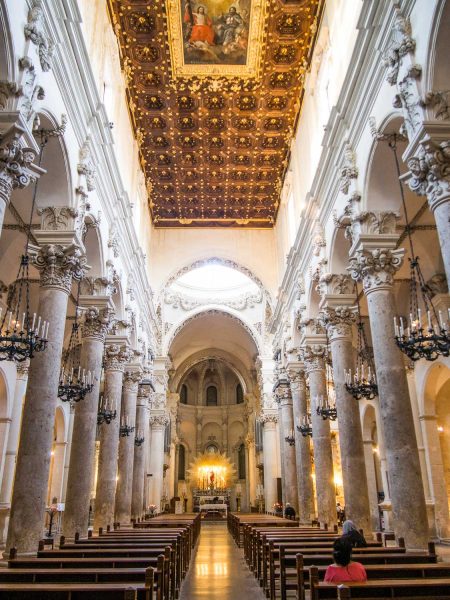
Lecce’s most extravagant baroque church is Santa Croce, also designed by Zimbalo. Unfortunately during our last visit in May 2018, the facade was covered as it was undergoing restoration works. You can still go inside and admire the ornate columns and decorative ceiling.
Next to Santa Croce is another Zimbalo creation, the Palazzo dei Celestini, now the seat of the local government. After admiring the exterior you can walk through the courtyard and out the archway to reach Lecce’s park (see below).
Just beyond the church and palace is a lovely little street full of wine bars—perfect for a light lunch or aperitivo.
Santa Croce is free. I’m not sure of the opening hours but like most churches it closes in the afternoon.
Church Tour
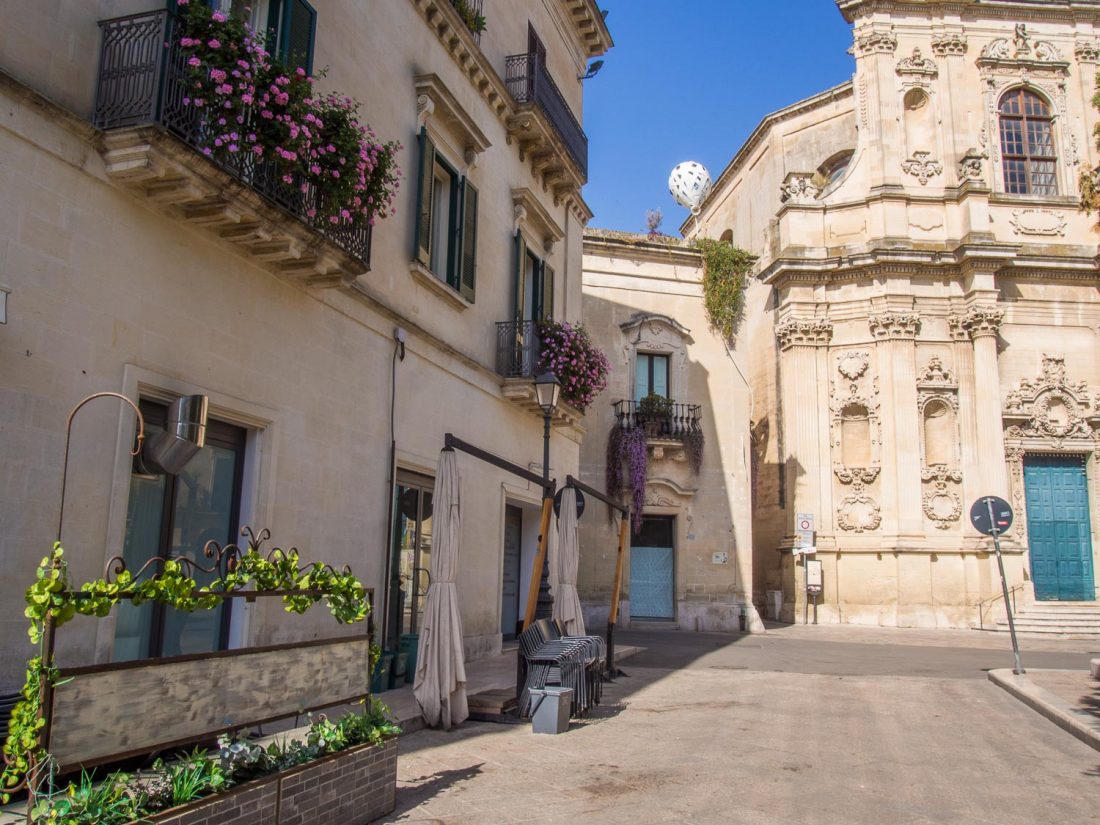
Santa Chiara church is on a cute piazza
There are so many other churches to explore in Lecce—wander randomly and you’ll come across them or follow the trail on the city tourist map. A few to look out for are Santa Chiara, San Matteo, Santa Irene, and San Giovanni Battista.
Most churches are intricately decorated in the 17th-century baroque style with cherubs, gargoyles, and gremlins carved out of the soft Leccese stone.
Evening Passeggiata
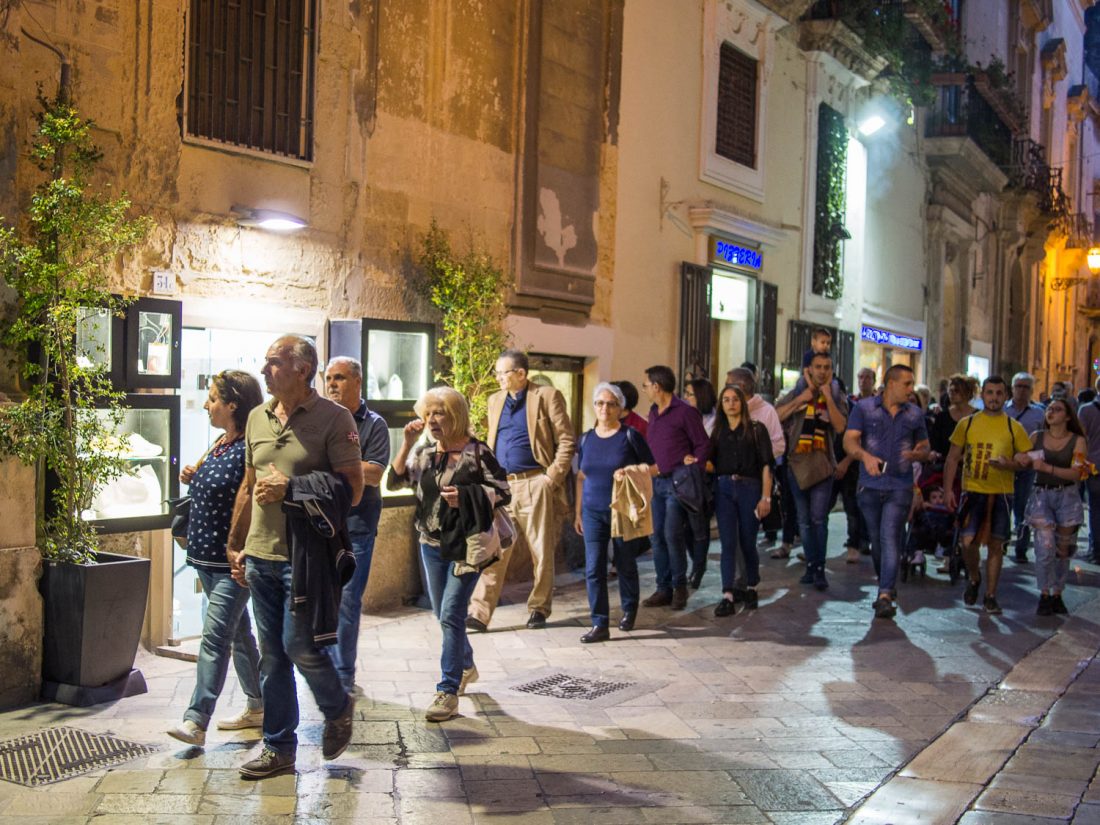
Passeggiata in Lecce
If you want a real experience of Italian life, join the evening passeggiata when locals of all ages take a pre-dinner stroll. The streets come to life after the afternoon slumber and the buildings turn golden as the sun sets. The heart of the action is Via Vittorio Emanuele II between Piazza Sant’Oronzo and Piazza del Duomo—on weekends it gets very busy, but it certainly is lively.
Cooking Course
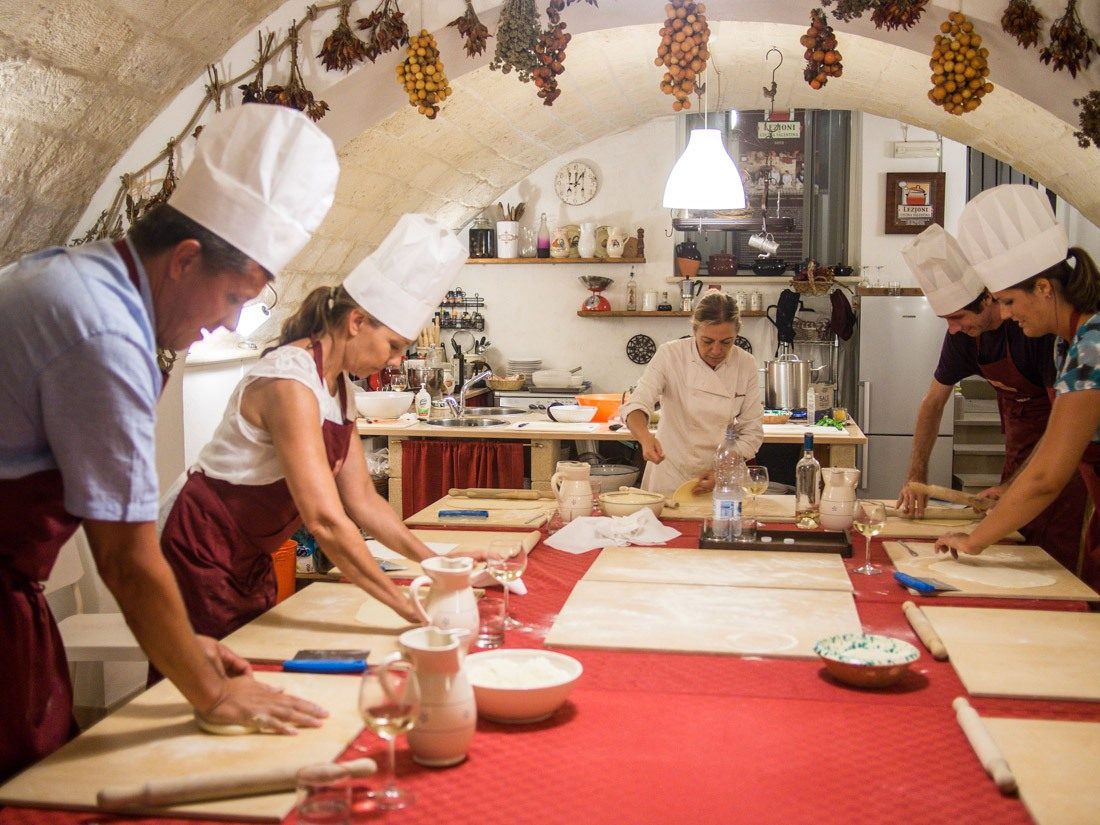
Learning to make pasta in Lecce
Our favourite experience in Lecce was taking a cooking class with Cooking Experience Lecce. We joined local chef Gianna for a tour of the city’s produce market before heading to a 17th-century palazzo for a fun, informal cooking class. We all pitched in to make local specialities like parmigiana di melanzana (eggplant parmesan) and orecchiette pasta before enjoying a leisurely dinner on the terrace.
A cooking class is a great way to learn more about the local food, have a unique experience, and enjoy a delicious meal.
Read more about our Lecce cooking class experience.
Lecce Portas
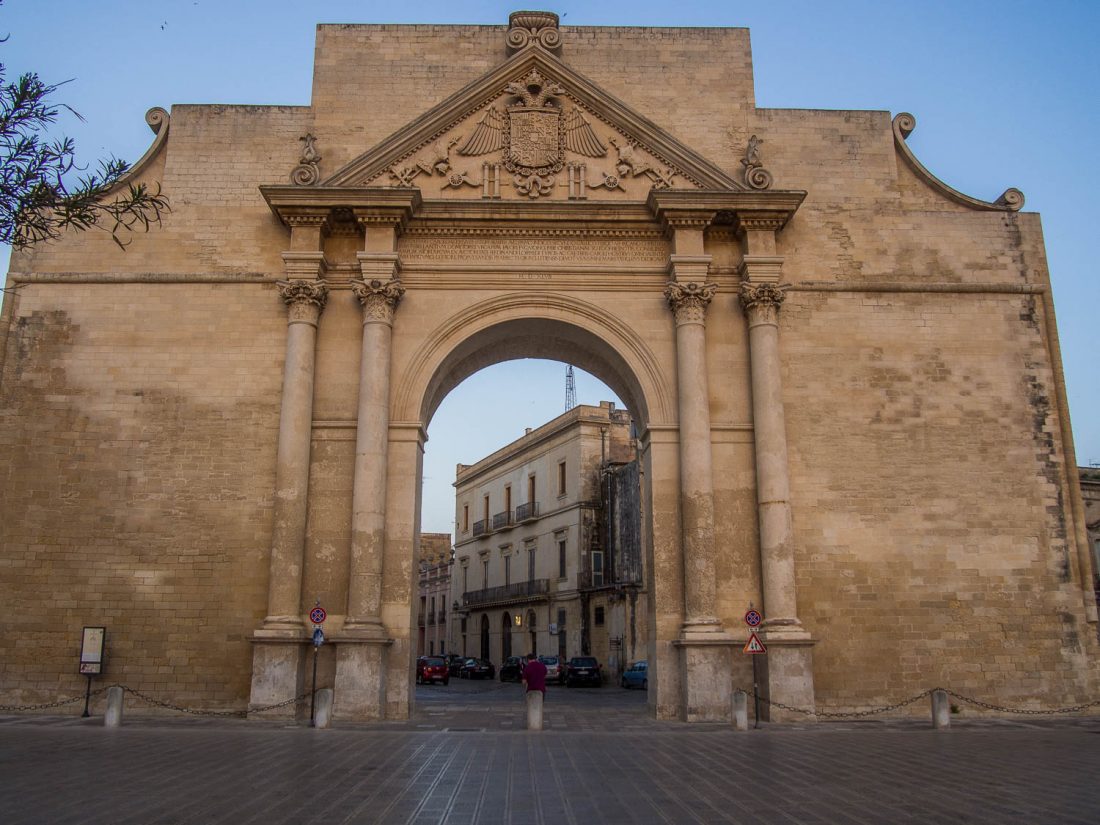
Porta Napoli
The three remaining city gates of the previously walled city are useful landmarks for navigating the city and all are decorative and worth seeing. Once you pass through the gates, you leave the historic centre behind for the modern part of the city which is less attractive, but it does have some good restaurants and shops.
The main city gate is Porta Napoli built in 1548 for a state visit from Charles V and modelled on a Roman triumphal arch. Just outside the arch is the obelisk and beyond this is the university area.
Further south on the same side of the city is Porta Rudiae, the oldest of the gates, which is topped by statues of saints. Just outside is the small produce market.
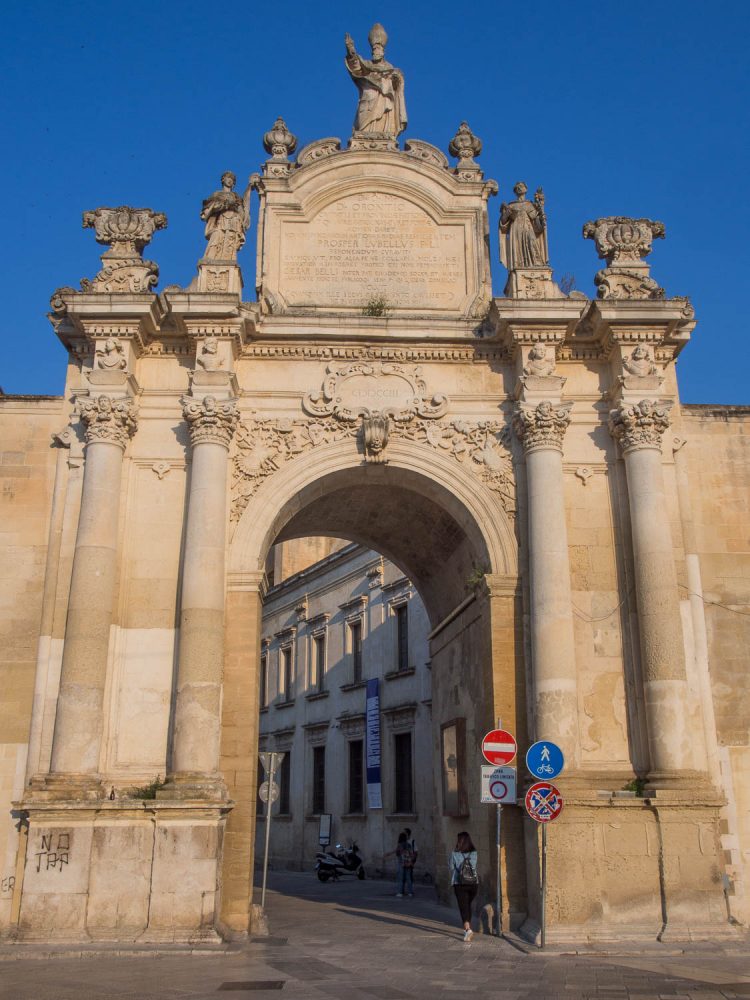
Porta Rudiae
On the other side of the centre is Porta San Biagio, probably the least visited gate but it’s still impressive.
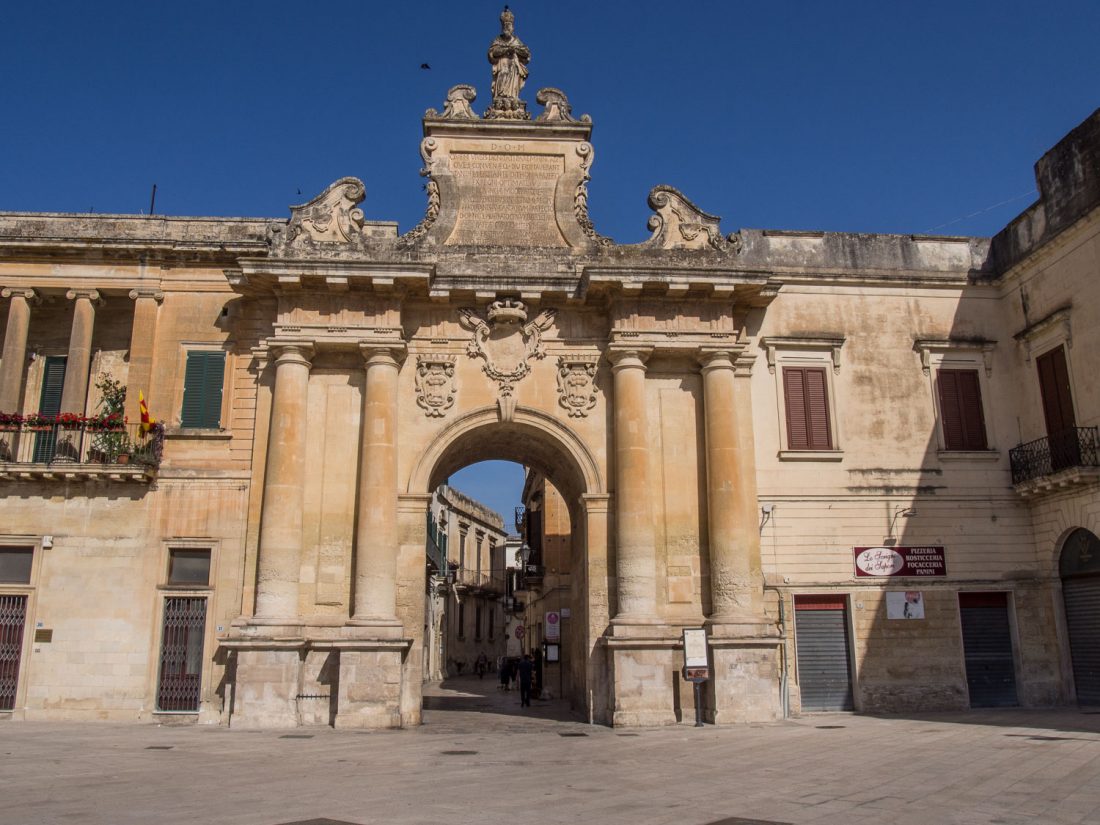
Porta San Biagio
Museo Faggiano
We don’t usually visit archaeological museums but we were intrigued by Museo Faggiano because of its origin story. It was a normal private house until 2001 when the owner needed to break into the floor to deal with a sewerage problem. Below the family discovered layers of archaeological remains dating back 2500 years.
You can do a self-guided tour of the house and see what they uncovered including underground cisterns, tombs, escape holes, and secret passageways. The building dates back to pre-Roman times and was a Knights Templar house from 1000 to 1200 and a convent of Franciscan nuns until 1600.
Museo Faggiano is open all day from 9.30 am – 8 pm. Entrance is €3.
Palazzo Taurino Jewish Museum
Palazzo Taurino opened in 2016 to highlight the little known Jewish history of Lecce. We hadn’t realised that this area was a thriving Jewish community in the Middle Ages until they were expelled around 1540. Most of the Jewish buildings were destroyed and baroque churches were rebuilt on top, including Santa Croce (next to the museum).
Entrance includes a guided tour and at the end there’s a moving video about another aspect of Jewish history in the Salento when Jewish refugees after WW2 were put in camps here and worked in partnership with local Catholics.
Palazzo Taurino is open every day from 10 am – 1 pm and 4 pm – 7 pm (mornings only on Sundays). Entrance is €5 and includes a 30-minute guided tour.
Roman Theatre
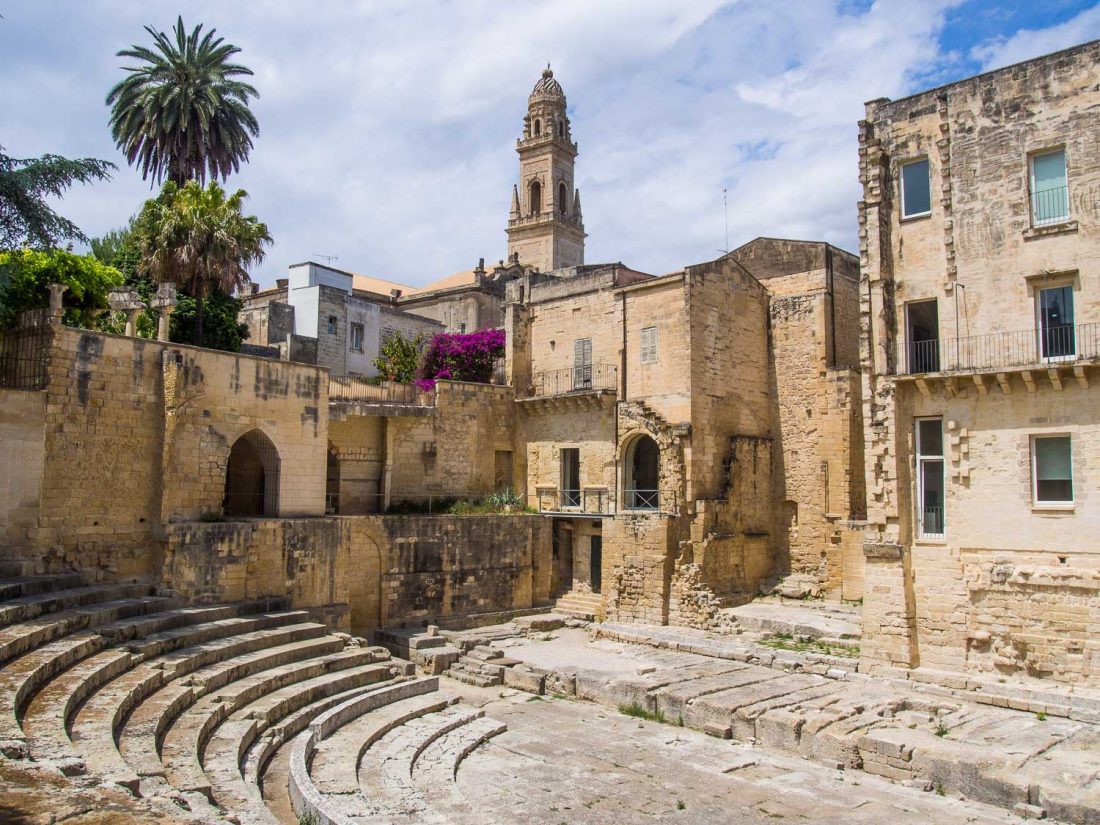
Hidden amongst the narrow streets of the baroque city is a 2nd century CE Roman Theatre that once seated 4000 people and was only rediscovered amongst the gardens and palaces in 1929.
You can see the theatre from Via Arte della Cartapesta, a small street to the left of Chiesa Santa Chiara. To go inside, the entrance is on Via degli Ammirati and costs €3 and includes entrance to a small museum. Opening hours are limited (mornings are probably the best time).
Convitto Palmieri
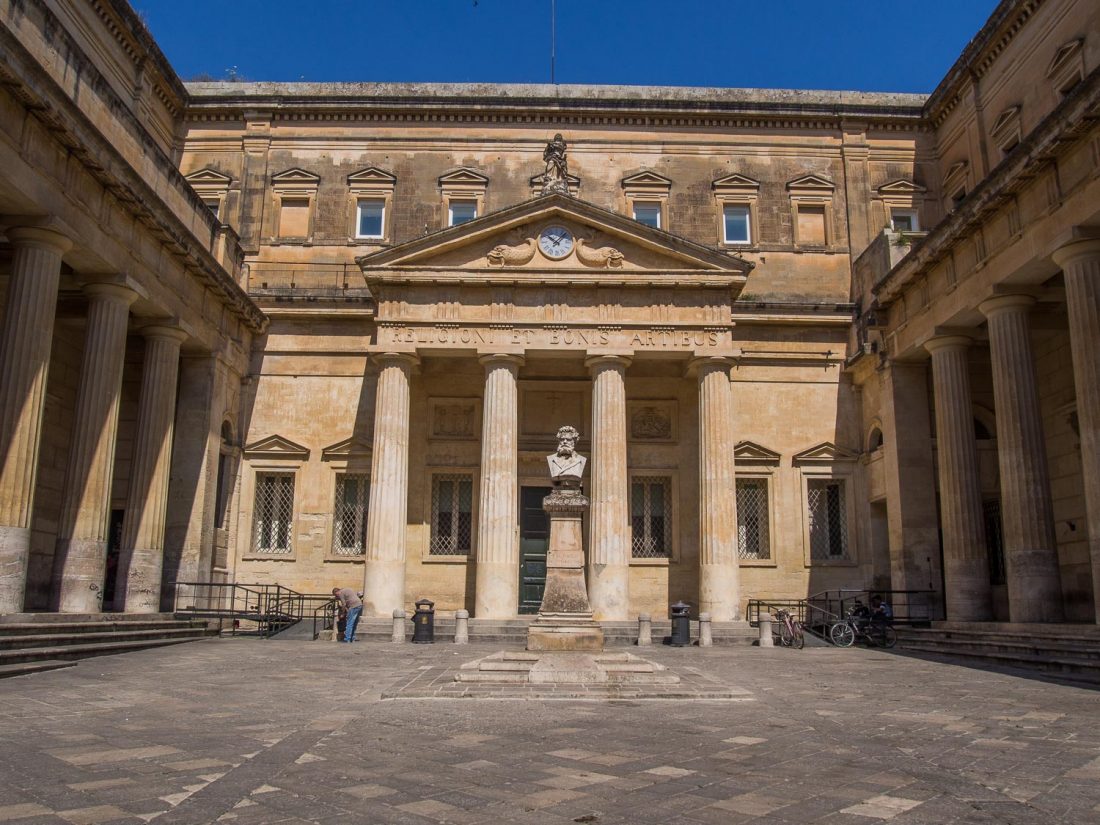
Convitto Palmieri isn’t a tourist attraction in Lecce. I discovered it by accident and was amazed that this grand column-lined square wasn’t marked on the tourist maps. The building houses a library and the square is a hang out for kids in the evenings with a couple of bars opposite.
Villa Comunale Park
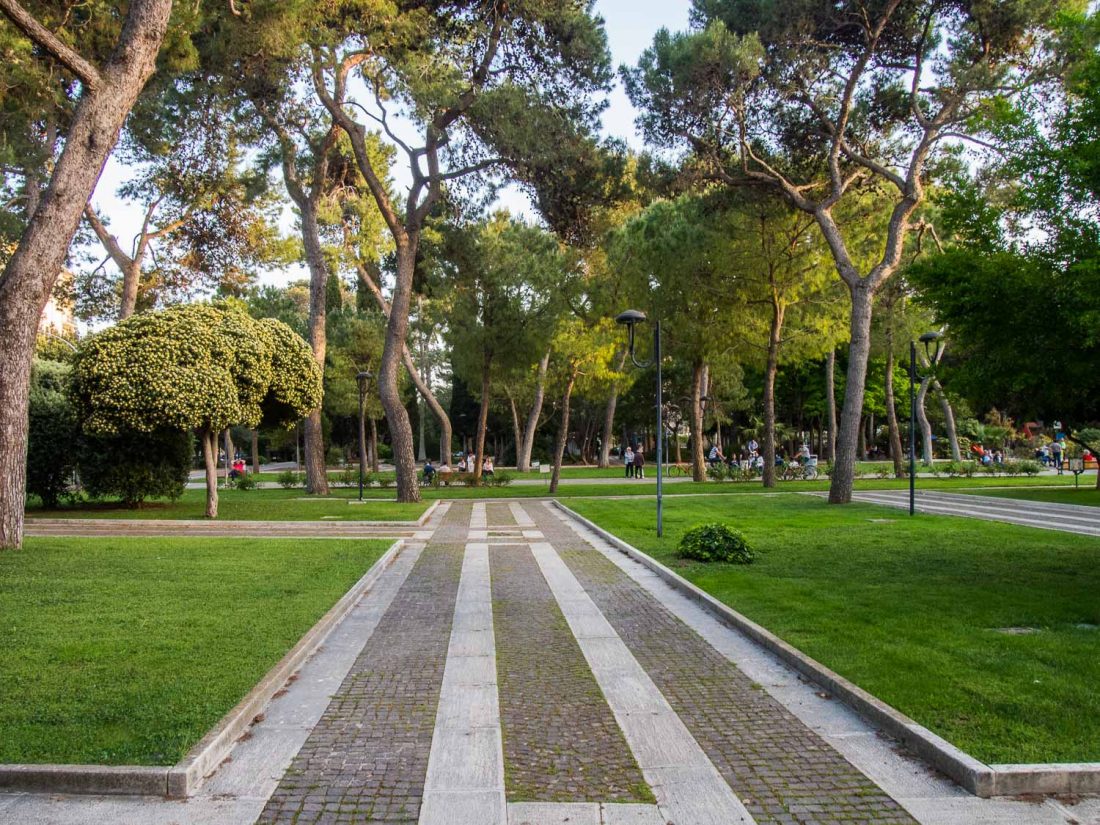
Lecce’s most pleasant green space is the small Villa Comunale just outside the centre. It’s worth visiting for a short stroll or picnic.
Day Trips from Lecce
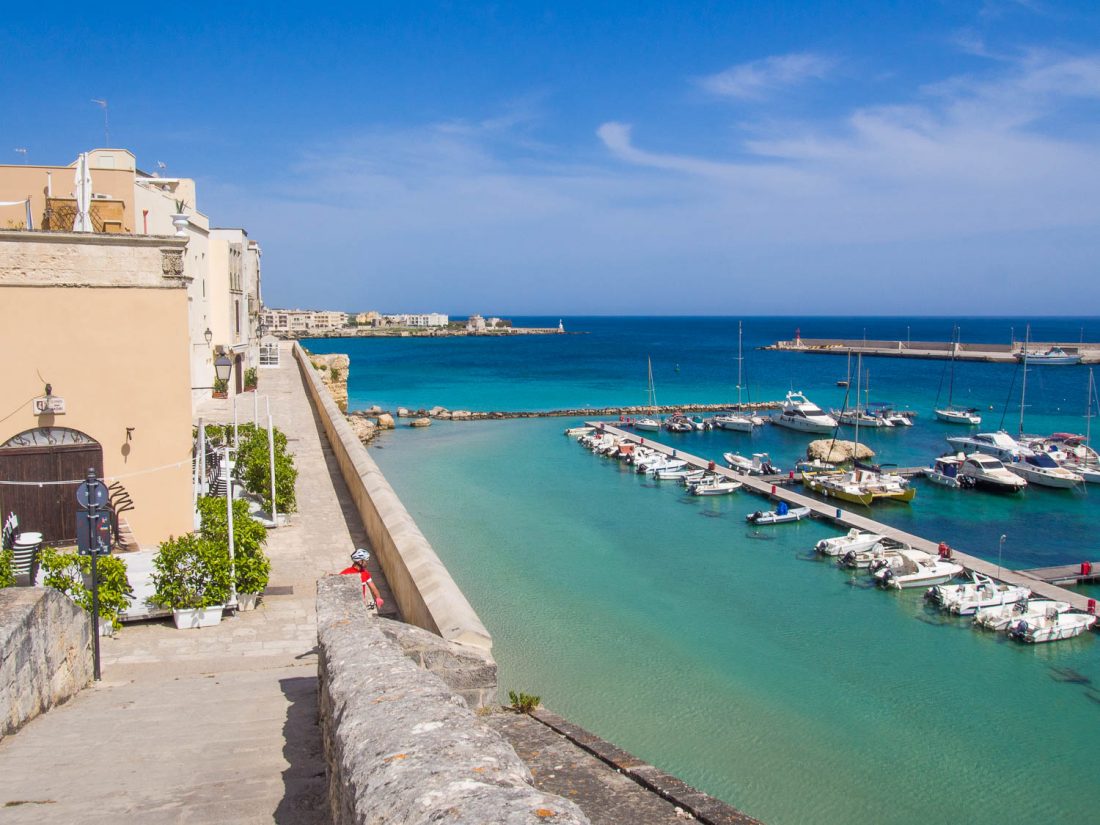
Otranto is a great day trip from Lecce
Lecce is the ideal base for exploring the Salento region as it’s located between the Adriatic and Ionian Seas so you can reach all of the peninsula’s sights within 30–60 minutes. In just over an hour you can also visit the gorgeous towns of the Valle d’Itria further north, but I prefer to stay in that area for part of my time in Puglia.
Having a car is by far the easiest and quickest way to take day trips from Lecce as public transport is limited (see the Getting to Lecce section below). To cover a lot of ground without a car you could take one of the tours offered by the tourist office in the main square. They offer a variety of tours in 9 person minivans for €60 for a full day.
I will be writing a guide to the Salento soon, but in the meantime, you can read my post on the best towns to visit in Puglia. Here are my favourite places to visit with driving times from Lecce:
- Otranto (40 minutes) – A beautiful seaside town overlooking the turquoise sea.
- Coast North of Otranto (approx 35 minutes) – Some great beaches including Torre dell’Orso and the unique Cave of Poetry swimming hole.
- Gallipoli (35 minutes) – Another lovely seaside town with a beach and old olive press to visit.
- Galantina (25 minutes) – A small town with a baroque centre that’s often overlooked.
- Coriglione d’Otranto (25 minutes) – An untouristy town with an interesting medieval castle.
The nearest beach to Lecce is San Cataldo, but a better option is the string of beaches north of Porto Cesareo including Torre Lapillo and Punta Prosciutto. Unfortunately it rained on the day we planned to visit so we haven’t been yet.
Where to Eat in Lecce
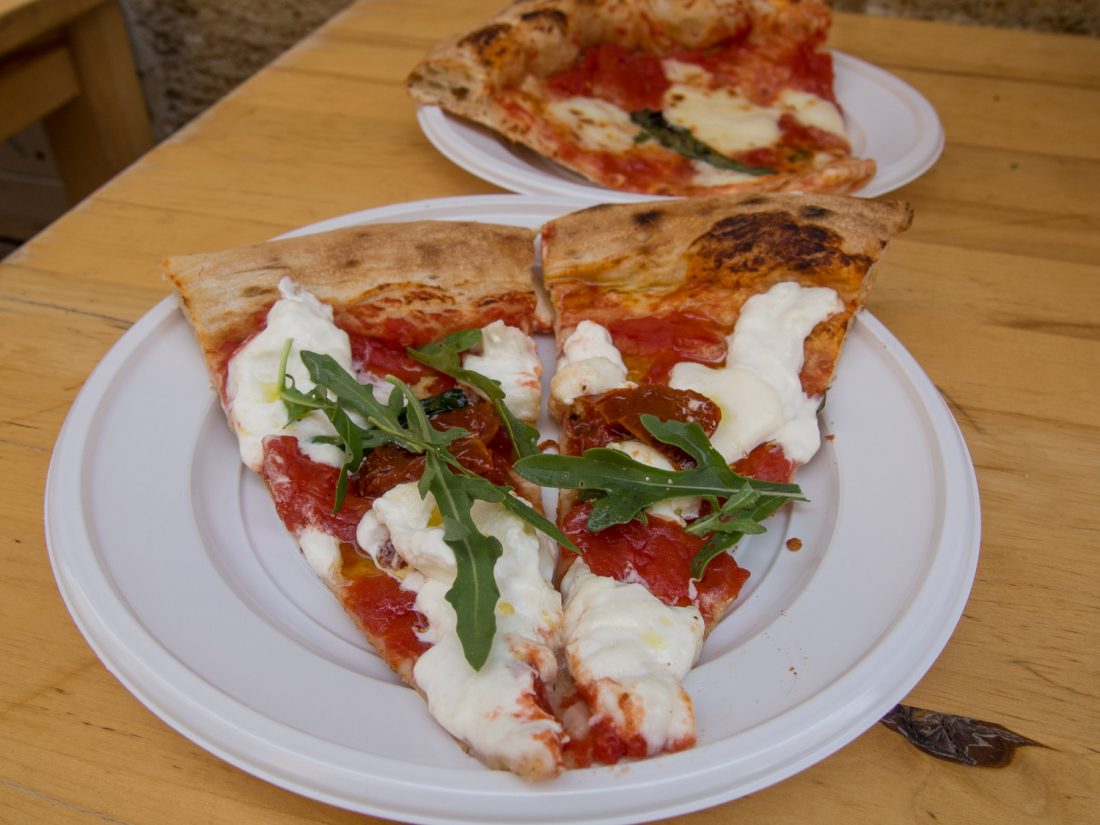
Burrata pizza at Pizza & Co
I will be writing a detailed guide to the best local dishes and restaurants to try in Lecce, but in the meantime here are our top picks:
- Pizza & Co – Absolutely delicious pizza slices. Perfect for a quick, inexpensive meal.
- Baldo – Our favourite gelato spot.
- Enoteca Mamma Elvira – Brilliant wine bar with a huge selection of wines by the glass and delicious light meals.
- Osteria Da Angiulino – Excellent value traditional food.
- Alle Due Corti – Another great spot for traditional dishes.
- Osteria degli Spiriti – A more upmarket restaurant with an excellent multi-dish antipasti.
Where to Stay in Lecce
I recommend staying within the historic centre if possible as it’s much more attractive than the modern part of town. That said, if you have a car it will be easier to find parking outside the centre (where traffic is restricted).
Airbnb Apartment
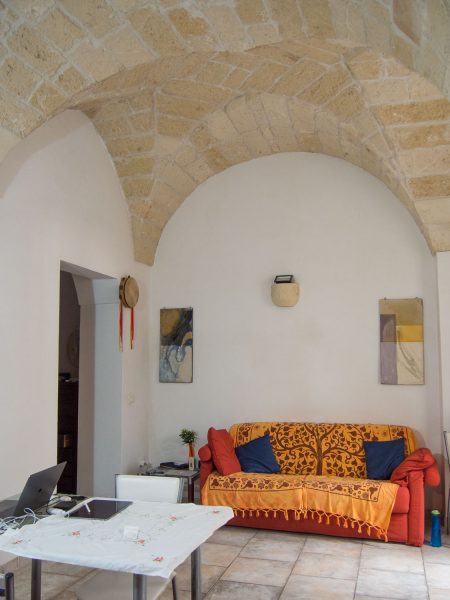
Our Airbnb apartment in Lecce
Airbnb is a great alternative to hotels and can be better value. If you haven’t tried it before, sign up here for £25 off your first stay.
On our latest month-long stay in Lecce we rented this Airbnb apartment. It’s in the perfect location just a few minutes walk from the main square but on a quiet street that made me happy every time I stepped onto it. The hosts are super friendly and even picked us up from the train station, the lovely vaulted stone ceilings are characterful, the WiFi was surprisingly fast (67 Mbps down/8 up), and the underfloor heating kept us warm in April (these old buildings stay very cool).
There were two downsides: noisy neighbours (although it feels very Italian!) and a lack of natural light. Overall it’s good value and I’d recommend it for shorter stays.
You can find more apartments on Airbnb here.
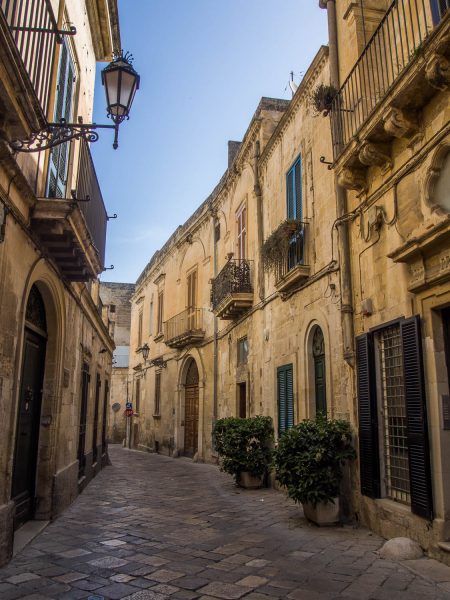
Our street in Lecce
Lecce Hotels and B&Bs
Luxury
- Dimora Storica Torre Del Parco 1419 – My top pick for a luxury stay is this gorgeous hotel in a medieval castle with its own tower just outside the centre. The stylish rooms have been lovingly restored with antique furniture and modern facilities. Book the hot tub suite for special occasions! The classic rooms can be surprisingly affordable if you book in advance.
- La Fiermontina Urban Resort – This 5-star hotel is the only place within walking distance of the centre with a swimming pool. It looks very stylish and peaceful.
- Vico della Cavallerizza – Characterful rooms in an ancient palazzo in the heart of the historic centre. Some of the rooms have frescoed ceilings and all have balconies.
Mid-Range
- B&B Le Caruse – Friendly B&B with clean, modern rooms just outside Porta San Biagio.
- Palazzo Bignami – Comfortable, stylish B&B with a roof terrace just outside the centre.
Budget
You shouldn’t have a problem finding a room in a B&B for under €50 in Lecce.
- B&B Cuore Barocco – One of the cheapest places to stay right in the centre but the rooms look lovely.
- 19Venti – Inexpensive rooms near the park with all the facilities you need.
- Spiriti Suite – We stayed in one of these good value, elegant suites on a previous trip. It is a 10-minute walk from the historic centre though.
You can search for more hotels and B&Bs in Lecce here.
Lecce Shopping
Clothes and Souvenirs
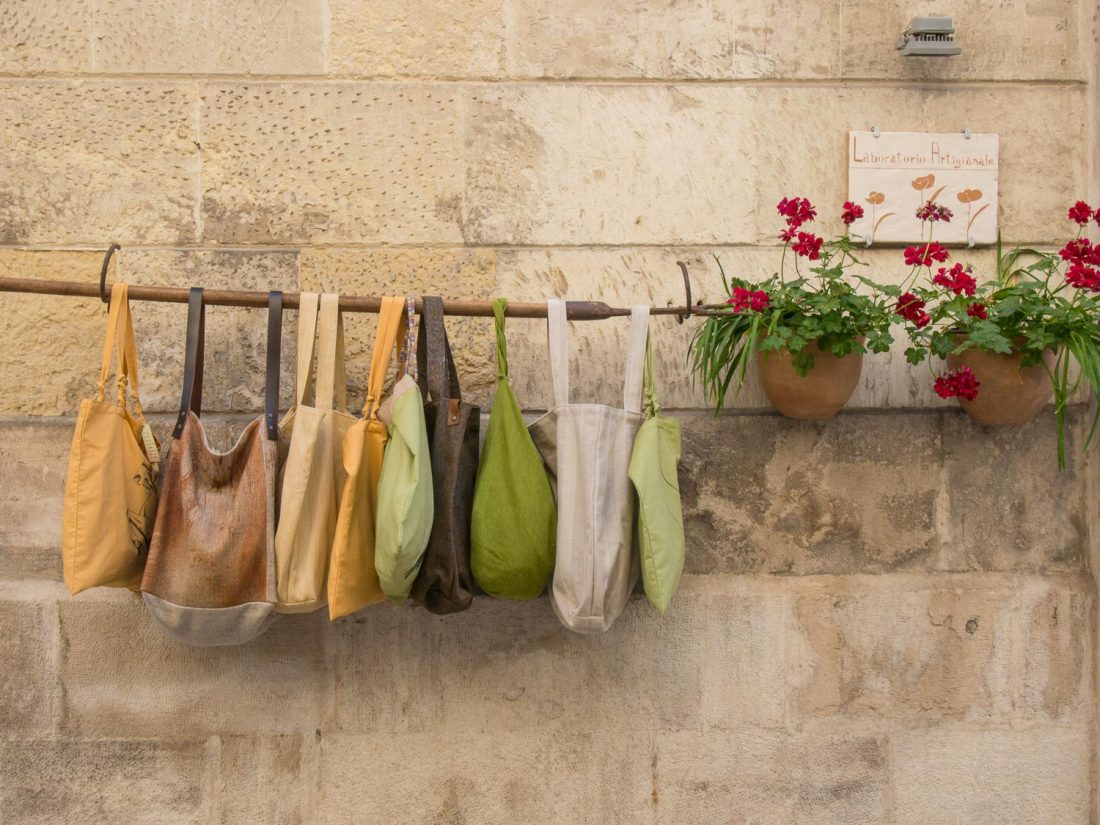
We’re not into shopping, but Lecce does have lots of cute looking independent clothing, jewellery, and craft stalls. Good streets to browse are Via Palmieri and Via Vittorio Emanuele II.
For chain clothing and lingerie stores head out of the centre from the main piazza along Via Salvatore Trinchese. Unlike most of the small shops, many of the chains stay open all afternoon.
Lecce is famous for its papier mâché (cartapesta in Italian) which was originally used for creating religious statues that were lighter to carry for festivals. You can find a few small studios around town to pick up a unique souvenir such as Cartapesta Riso on Via Vittorio Emanuele II.
Food
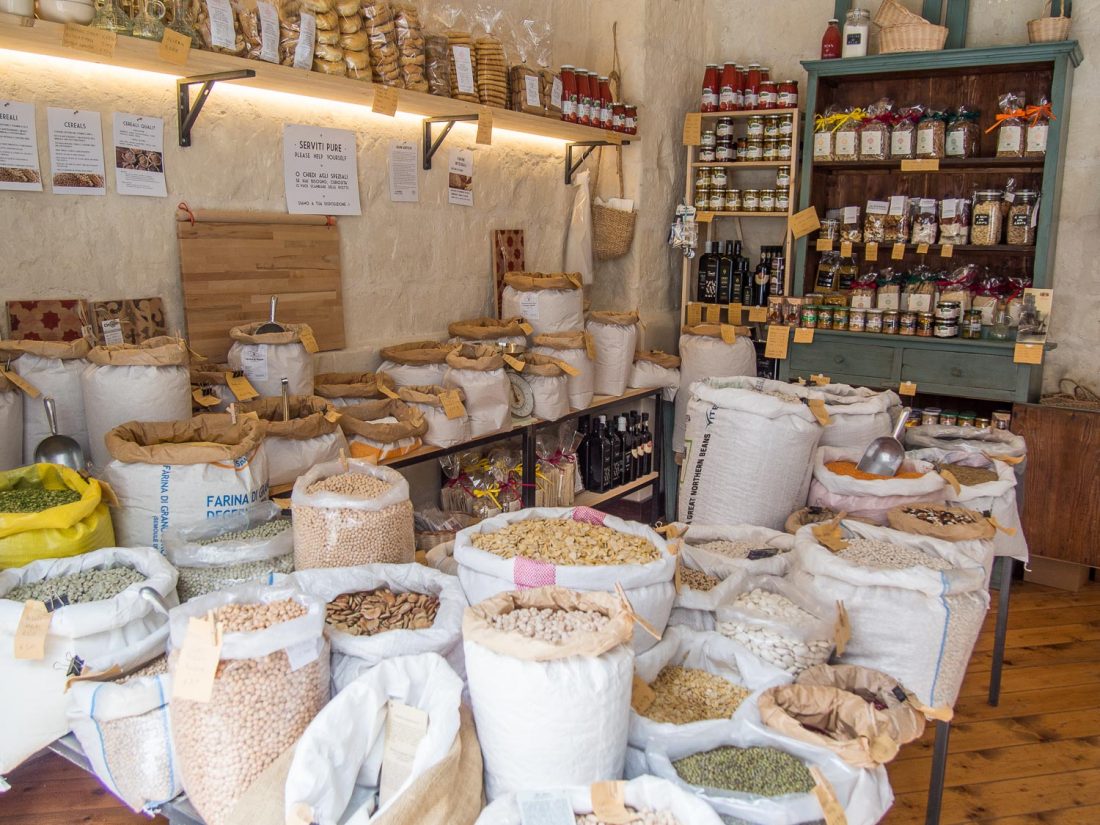
La Dispensa, a fantastic food shop in Lecce
- Morning market – Just outside Porta Rudiae is a small market where you can pick up local produce.
- La Dispensa – A beautiful bulk buy shop full of beans, lentils, unusual flours, spices, and nuts. This would be a good place for foodie gifts too.
- Biweekly market – Unfortunately Lecce’s market (Mondays and Fridays) is quite far out of the centre near the stadium. It’s huge and consists mostly of cheap clothes, although there are some good, inexpensive produce stalls selling fruit, vegetables, olives, nuts, and dried beans. It’s not worth going out of your way for unless you have a car and are self-catering.
- Dok – The biggest supermarket in the centre.
Where to Run in Lecce
It’s best to run as early as possible to beat the heat and to avoid the crowds when running through the centre.
The small park Villa Comunale close to the centre would be good for laps, but it doesn’t open until 9 am so was no good for me. For short runs I headed instead to the Parco di Belloluogo next to the cemetery (leave the old city from Porta Napoli). It opens at 8 am and there are toilets and water taps. A full loop is around 1.5km and takes you past a tower and olive trees.
For longer runs I headed out of town into the countryside along Via Vecchia Frigole north of the centre. It starts out as pavement, turns into a cycle path, and then becomes a quiet country road. You do have to cross over a highway at one point, but there was no traffic early on Sunday mornings.
Getting to Lecce
By Train
You can reach Lecce easily by direct Trenitalia train from cities such as Brindisi (30 minutes), Bari (1.5 hours), Rome (5.5 hours), and Bologna (7 hours). From Naples you’ll have to change trains at Caserta (5.5 hours total). Check timetables and book tickets in advance for the best rates from the Trenitalia website.
The Bari to Lecce Trenitalia train stops at a number of places in Puglia including Polignano A Mare, Monopoli, Cisternino, and Ostuni.
Lecce is also on the local FSE train line, but these trains are much slower, less frequent, and can be unreliable. You can reach Gallipoli direct in 1.5 hours and Galatina in 45 minutes. Getting to Otranto involves two changes (at Zollino and Maglie) and takes at least 1.5 hours.
Make sure you check outward and return train times before you set out on a day trip. Avoid travelling on Sundays when services are even more limited.
In summer 2018 (from 18th June to 9th September), FSE are running extra trains in the Salento including a direct train from Lecce to Otranto (1 hour 10 minutes), which will make travelling around the region a little easier.
By Car
You don’t need a car in Lecce as it’s small enough to walk everywhere and parking isn’t easy, but if you’ll be exploring the area it’s much easier to do so by car than by public transport.
On our first two short trips to Lecce we had a car. On our latest long stay we arrived by train from Bologna and rented a car for just a few days for some day trips. We had intended to get around by public transport, but the schedules were so limited and the journeys so much longer that we decided to rent a car. You can search for cheap car rental deals on Kayak and Rental Cars.
We booked via Expedia with Maggiore—booking a week in advance for a small Fiat Punta for three days for just £20 ($27). It was a rather old car with no USB socket and the lady in the office was very grumpy (she was not pleased we hadn’t printed out our booking), but you can’t beat the price. The Maggiore office is a 20-minute walk from the centre out of Porta Napoli.
When we left Lecce we rented a car for a one way rental from Lecce to Foggia for a two-week road trip along the length of the region. It cost £232 ($311) for 15 days including one-way fee with Avis (again booked via Expedia) who were more professional than Maggiore and our car was more modern with a USB socket. The Avis office is a 20-minute walk south of the centre past the train station.
Once we dropped the car in Foggia we took the train to Rome (3 hours).
I recommend renting the smallest car as it’s easier to navigate Italy’s narrow streets and park.
Check with your accommodation in Lecce about where to park. We found free street parking outside the old city just north of the station on Via Giuseppe Petraglione.
From the Airport to Lecce
The nearest airport to Lecce is Brindisi (30-minute drive), while Bari airport is a 2-hour drive away. You can rent a car at Brindisi airport or take a shuttle bus from the airport to Lecce (40 minutes, €6.50).
The Best Time of Year to Visit Lecce
We have visited Lecce in April, May, June and September and the weather was hot and sunny most of the time. The summer months July and August are very hot and crowded and it’s best to avoid visiting then if possible. June and September have reliable weather and are probably the best times to enjoy the beaches without huge crowds.
In April-May it was sunny most days with daytime temperatures in the high 20s Celsius and night temperatures around 17–20ºC—by the end of April we could go out for dinner without a sweater. We did have a couple of rainy days though. October would be similar.
If you aren’t bothered about sunbathing on the beach, then winter isn’t a bad time to visit. The weather will be variable, but you’ll benefit from lower prices and fewer crowds.
Lecce Italy Map
Resources for Planning a Trip to Lecce
- Guidebook – I like Lonely Planet Southern Italy (updated in 2018) or Lonely Planet Italy if you are travelling in the north too.
- Travel insurance – Essential in case anything goes wrong. The best value we’ve found is True Traveller (UK/EU citizens), which we’ve been using for the last six years. World Nomads (worldwide) is another reliable option that we’ve used in the past.
- Accommodation – Search on Booking.com (hotels and B&Bs) and Airbnb (rooms and apartments—get $38 off here).
- Flights – Look on Kiwi.com for flights to Brindisi. It offers a lot of flexibility to help you find the best deals (choose a date range to find the cheapest day to fly).
- Train travel – See The Man in Seat 61 for the best advice, read our post on travelling from London to Italy by train, and consider an Interrail or Eurail pass if travelling to multiple destinations in Europe.
- Pack light – To avoid paying checked luggage fees on airlines. My book, The Carry-On Traveller: The Ultimate Guide to Packing Light, shows you how to travel with just carry-on luggage on any trip.
- To track your travel expenses use our iOS app Trail Wallet, which will help you stay on budget and know how much you’re spending in both Euros and your home currency.
- See our travel resources page for more tools and gear recommendations to help you plan your trip.
More Puglia Tips
- 8 Towns Not to Miss in Puglia
- Puglia Food Guide
- The Best Masserie in Puglia: Experience Life on an Italian Farm
- A Guide to Ostuni, Puglia
Lecce is one of our favourite cities in Italy. We love the beautiful architecture and lively yet relaxed atmosphere. I hope you add it to your Puglia itinerary and that this post helps you make the most of your stay.
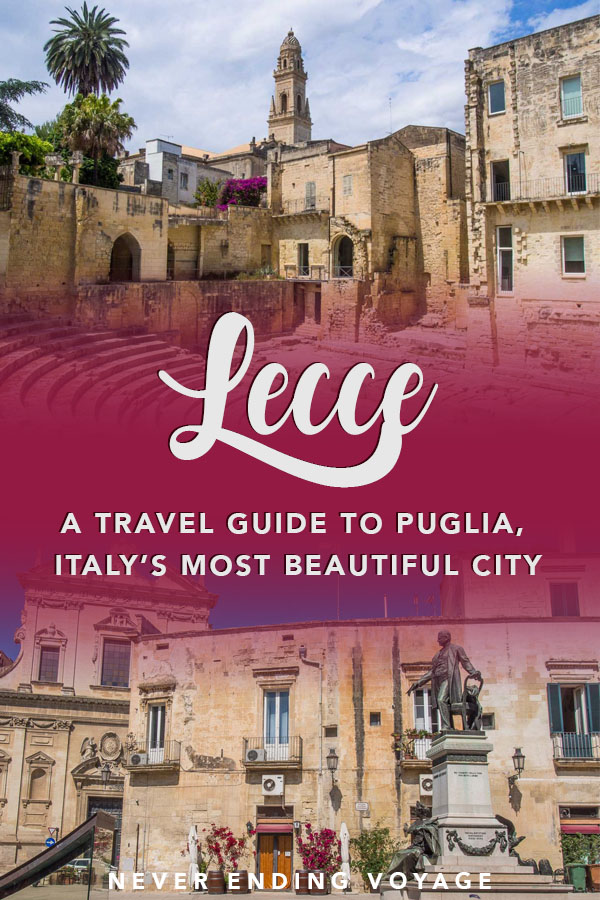
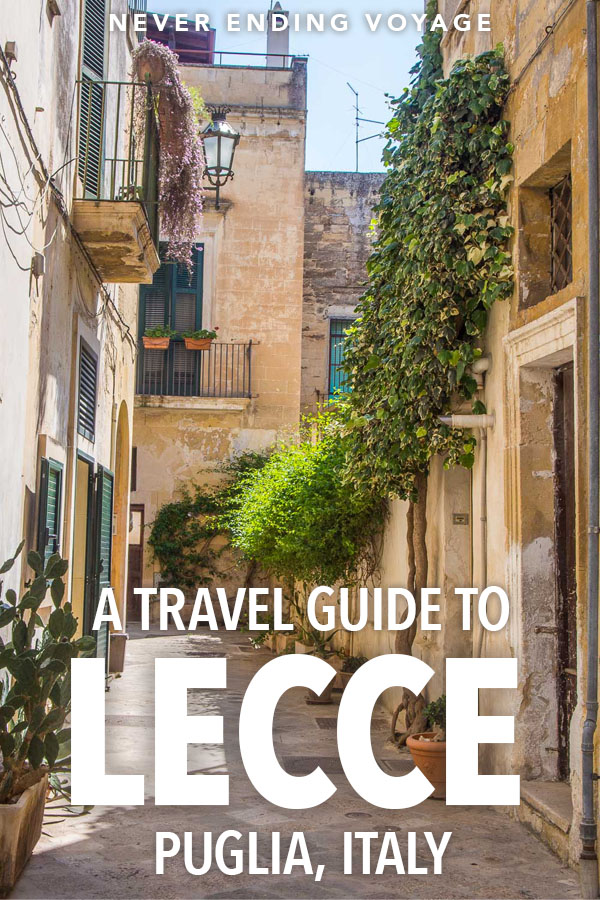
If you enjoyed this post, pin it!
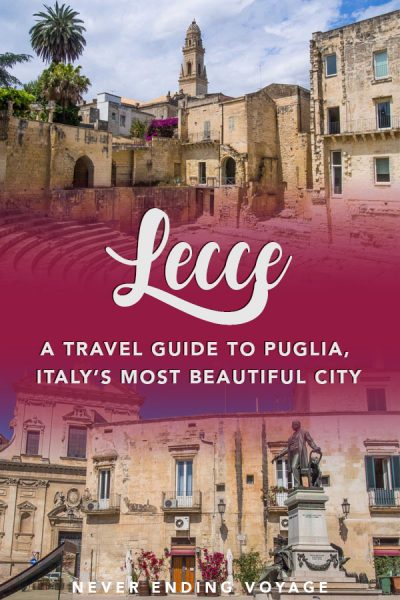
neverendingvoyage.com

